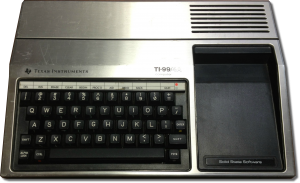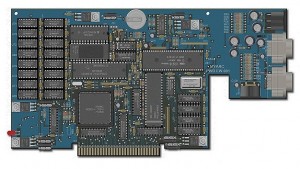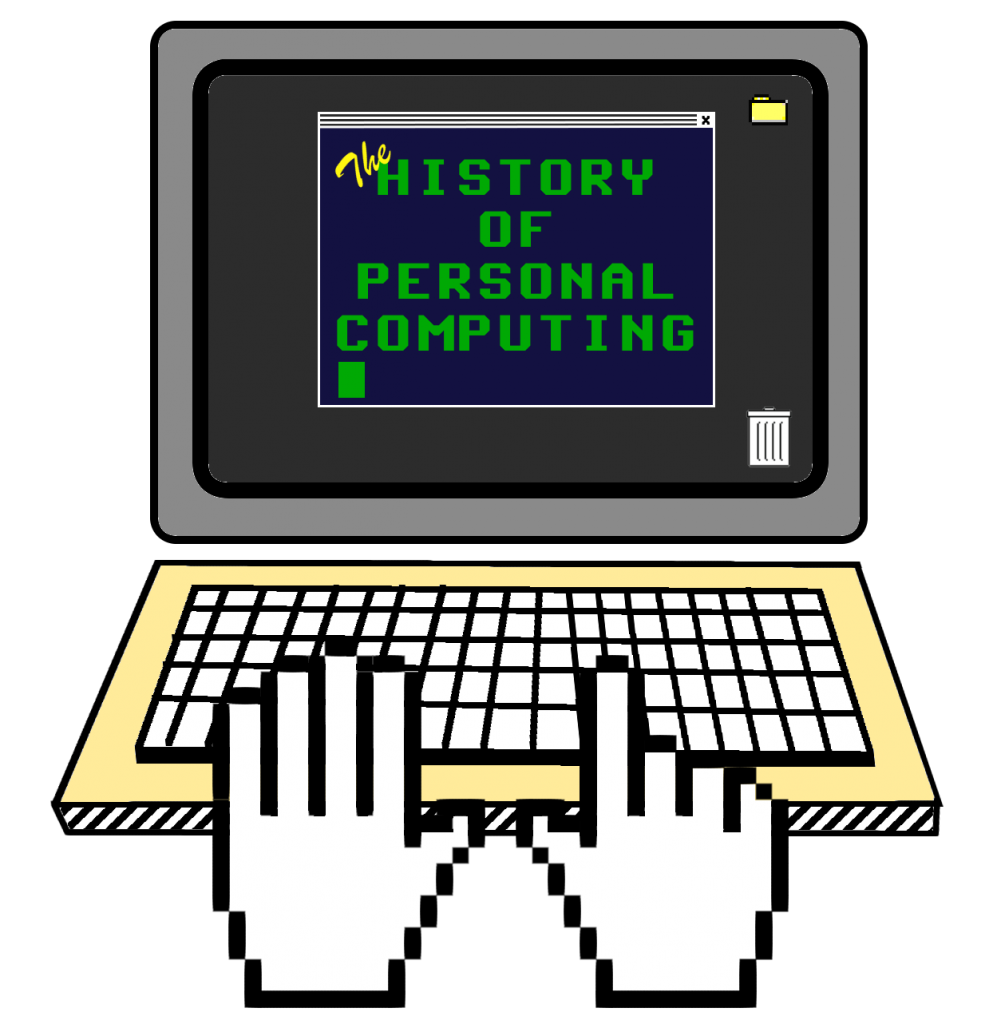Texas Instruments TI-99
Texas Instruments has always been a leader in microprocessor technology. After a few years as a top manufacturer of electronic calculators using their custom microprocessor technology, and a foray into minicomputer systems using their 16-bit TI-990 processors, Texas Instruments decided to throw its hat into the ring of the home computer market in 1979 with the TI-99 computer system.
| Listen to our podcast episode about the TI-99 computer here |
History
The first TI-99 was called the TI-99/4. It had a chicklet style keyboard that looked more like Texas Instruments calculator buttons than an actual typewriter style keyboard. Outside of its odd keyboard, It’s features were comparable to other home computer systems of the day, except it used a 16-bit TMS-9900 microprocessor, and cost $1150. However, that price included a modified 13-inch Zenith television which worked solely as a color monitor.
The TI-99/4 did not fit into the market very well and had poor sales. The entry price was considered rather steep, especially since people found they could just hook it up to any composite monitor available elsewhere. So, some revisions were made to its design and configuration. A pull here, a tweak there, and the result was the TI-99/4A computer released in 1981, commonly referred to as the TI-99.
The new TI-99 sported 16K of RAM, a TMS 9900 CPU running at 3 MHz., a custom TMS9918A Video Display Chip, and a 48 key keyboard with full typewriter style keys. It sold without the monitor for literally half the price of the TI-99/4, or $525, but included an RF modulator that allowed you to connect it to a TV. The newly revamped keyboard shared the slightly diminished dimension of the TI-99/4 keyboard. It wasn’t a bad keyboard, but it was a bit cramped.
To the right of the keyboard was the cartridge slot which was used to insert one of many patented Solid State Cartridges for gaming, programming, and utility needs. This had not changed from the earlier /4 version. Texas Instruments actually banked on the idea that people wanted the use of their computer to be as simple as possible, so they marketed just about all of their software line as a plug-in Solid State Software cartridge. The problem with that philosophy was that the costs involved making the cartridges made the software more expensive than comparable software sold on disk for other brands of home computers.
The system specs for the TI-99/4 and 4A are as follows:
- CPU: TMS9900 16-bit
- RAM: 16 kB
- ROM: 26 kB
- Video: 32×24 character display, 256 x 192 bitmapped
- Sound: 3 channel tone generator with optional speech syntesis
- Ports: Joystick, composite video out, cartridge slot, expansion port, cassette port
- 48 key chiclet keyboard (TI-99/4), 48 key standard keyboard (TI-99/4A)
Expansion
The TI-99/4 had numerous and relatively capable expansion options, which would also work on the 4A. But they were rather costly. Expansion was achieved through a side port on the computer. You could buy a number of external devices, called “sidecars”, The available sidecars were:
- Speech synthesizer: $150
- RS-232 with modem: $225
- Thermal printer: $400
- 32K memory expansion: $400
- Disk controller: $300
- Disk drives: $500 each
All of these would “sidecar” with up to five others out from the right hand expansion slot. If you owned all sidecar devices, you would have your TI-99 on the desk with a long extension of devices sticking out from its right side.
After the 4A version was released, a huge and heavy box called the Peripheral Expansion Box, or PEB, was released. This provided a more sensible, modular expansion form factor. It connected to the TI-99 by a large insulated ribbon cable referred to as the “fire hose.” The expansion box resembled an S-100 type of expansion in that it contained a power supply, and expansion cards were placed into expansion slots as desired. The expansion cards were purchased separately and were specifically designed for the PEB. The PEB could house one or two disk drives to be used in conjunction with the drive controller card. A typical desktop configuration for the PEB kit was to have the TI-99 sit in front of the PEB and the TV or monitor on top of the PEB.
Competition
By late 1982, Texas Instruments found themselves in a home computer price war. Commodore computers were packing a lot of features and seemed to be dropping their prices at regular intervals. Texas Instruments couldn’t keep up, but still competed in this price war by offering rebates and other deals. They even pushed a service called “The TI Computer Advantage Club” in major metropolitan areas in order to get families interested in using the TI-99 as a family computer.
But still hoping that they could make money on their Solid State Software modules, the TI-99 became a “loss leader” until an over $100 Million loss over the product in mid-1983 forced them to proceed in discontinuing the TI-99. The price was cut so low that retailers were able to sell them for about $50 around Christmas time. The TI-99 was officially discontinued by Spring of 1984.
Interesting “Bits”
In 1983, Texas Instruments had discovered a shock hazard with their transformer power supply. TI-99 computers used a small, inline transformer for external power, with the rest of the power supply inside the computer itself. The transformers could begin to overheat and create a shock hazard for the user if they touched an input port or the RF modulator. To correct the problem, Texas Instruments offered a free inline-fuse adapter. It looks like a very short extension cord with a box inline. The box contains a fuse that would blow in the case of a transformer short.
Legacy
Like a phoenix, the TI-99 was reborn through efforts from members of users groups, programmers, and hardware designers. The machine was actually quite capable and many believe Texas Instruments shot themselves in the foot by limiting their primary software line to cartridges, and restricting access to the system’s hidden capabilities. In 1987, a company called Myarc created a special card that plugged into the PEB, called Geneve 9640. The Geneve was basically a “computer on a card” and ran on a 12MHz TMS9995 processor and has an 80 column output. It ran almost all TI-99 software, but used an IBM XT keyboard for input.







January, 8th 2016 at 2:03 am
I’m rather saddened when I think about the 99/4a. I remember how it truly impressed me as a kid. Sure, it didn’t have the ‘whiz-bang’ of the Atari computers, but it this air of professionalism about it. T.I. was a well-established company, after all. They’re greatest hits started a decade before with calculators. My father owned one of their first (and I was, ‘by God, NOT allowed to TOUCH it’ for the longest time). 😉
The keyboard certainly felt better than the Atari 400… Well… I guess it had better when it cost more than the 800 did.
The expansions were really neat too. You know, if T.I. hadn’t been so greedy and shortsighted, they might have continued making their computers for some time. But, on the other hand, when your competitor is Mr. ‘Business Is WAR!’ Jack Tramiel… Mmmmaybe you want to stick to Speak and Spells… :/
– Like Radio Shack and Atari, T.I. wanted software control, but unfortunately for T.I., when they finally changed their mind about 3rd party software development, it was far too late.
T.I. was one of the few U.S. companies Jack Tramiel of Commodore actually feared because, like Commodore, they were able to produce all or most of the parts for their computers.
Jack didn’t fear Atari or Apple nearly as much because of vertical integration. With Commodore and T.I. owning their own chip plants, they could control their costs better than almost anyone else.
T.I. had a capable enough computer – 16 bits at a time when 8-bit was the standard – but they asked a lot for it. It was much more expensive to build than a Vic-20, because where Commodore had been using their own custom-designed chips for almost everything, T.I., amazingly, still used off the shelf components made outside their company and were at their mercy on pricing.
When T.I. started dropping prices and offering rebates, Jack Tramiel completely lowered the boom on them by a last-minute slashing of prices at the June 1983 CES show. It inevitably helped cost Jack his job, and it nearly bankrupted T.I.
– One notable thing about the T.I. was the speech synthesizer. I remember hearing this at a science museum and was blown away. The only other ones I’d heard was AT&T’s ‘singing’ demo from the 60’s, and Radio Shack’s speech synth for the TRS-80 that sounded like the computer had bees up it’s nose.
Hey! This was the demo I heard at the time (I was too young and mesmerized to be critical at the time). Hear it for yourself: https://www.youtube.com/watch?v=WeIJxXCh8P8
Intelligible speech was rare back then, but you heard the same chip at work in T.I.’s ‘Speak and Spell’ games. In 1983, the E.T. movie features this device in a critical scene.
True Story Bro: In the summer of 1983, I joined the Army and went to Basic Training. My closest friend there owned a T.I. His parents were convinced that this was a LEARNING machine, as opposed to one that played a lot of video games. Consequently, I felt sorry for him. 😀
Just a week before starting training, Commodore announced that the VIC-20 was going to sell for $149. There was no way that T.I. could really compete after that. Well… Not without losing significant amounts of money (which they did).
He told me all about Romox, and how it was going to save the 99/4a, and I just nodded my head in pseudo-agreement.
Romox, I later learned, had been one of the few companies who had been given a license to make ROM cartridges for the 99/4a. I remember seeing their ads in the home computer magazines. They were a big deal, mainly because other than T.I., they were the ONLY deal. :O
T.I., even as they were getting slammed in the market, threatened to SUE software companies that didn’t get that license! This was in AUGUST of 1983. CLUELESS! Can you imagine? What senselessness! I mean, you can point to the PEB, or ridiculousness of the ever-expanding expansion boxes, but to punish devs who have the temerity to write code on YOUR machines?!
Because T.I. wasn’t able to make money on the hardware anymore (thanks to Mr. Tramiel), they desperately tried to find a way to monetize their home computer operations – hence selling a ‘license’ to make games.
It was a $500 million dollar mistake (in total losses), that almost took down the whole company. All you can say about that today is, there were many hard lessons learned in those early days of home computing. The road went on ahead of you, and you really couldn’t see very far. The future is a difficult thing to predict.
Other than a basic understanding of Moore’s Law, and knowing what kind of devices might be capable in a few years, there’s really no way to know how people will use a certain technology. Remember: The iPhone only came out in 2007, and now Smartphones, Selfies, and Facebook are ubiquitous. Who could’ve predicted THAT?!